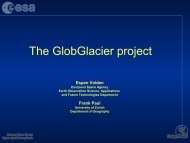proportion
Altai - GLIMS: Global Land Ice Measurements from Space
Altai - GLIMS: Global Land Ice Measurements from Space
- No tags were found...
Create successful ePaper yourself
Turn your PDF publications into a flip-book with our unique Google optimized e-Paper software.
D16107SHAHGEDANOVA ET AL.: GLACIER AND CLIMATE CHANGE IN THE ALTAID16107observed shrinkage rates. Therefore, the CG [1974, 1977]data can be used to assess changes in glacier areas in thestudy region. The 5.5% uncertainty value in the 1952 dataappears to be more realistic than ±2.6% error derived from theCG assessments of accuracy based on glacier size alone. The±5.5% error was assigned to the 1952 CG data.[16] Glaciers smaller than 0.5 km 2 (as in 1952) have beenexcluded from the assessment of changes because the CG[1974, 1977] reports a large error in estimation of glaciersize for the very small glaciers increasing from about 5% for0.5–1 km 2 glaciers to 10–25% for glaciers under 0.5 km 2 .Alimited availability of the original aerial photographs did notallow re‐mapping of a sufficient sample of very small glaciersto verify accuracy of the reported values. Changes inthe extent of 126 glaciers, whose individual glaciers werenot less than 0.5 km 2 in 1952, have been evaluated in thisstudy although a potentially significant contribution ofvery small glaciers to the net reduction in glaciated area isacknowledged [e.g. Paul et al., 2004].3.2. Climate[17] Two conventional meteorological stations, Akkemand Kara‐Tyurek located in the Katun Ridge, supply datafor the middle mountains in the Altai (Table 1). Glaciertermini descend to approximately 2300–2600 m a.s.l.,which is close to the station elevation. The Aktru stationlocated in the North Chuya Ridge (Figure 1) was closed in1994. The JJA temperature averages at the three stationscorrelated closely with correlation coefficients of 0.81–0.96.The correlation coefficients between annual precipitation totalswere lower (0.56 and 0.42 between Kara‐Tyurek ‐ Aktru andAkkem – Aktru respectively) but statistically significant at0.05 confidence level. The time series of air temperatureand precipitation from Akkem and Kara‐Tyurek were used toevaluate the observed variations in regional climate. Thestarting year for precipitation time series was taken as 1952when Tretyakov gauge replaced Nipher gauge. Uncertaintiesexist in gauge measurements of precipitation in Siberia dueto (i) wetting and evaporation losses from the gauges,(ii) underestimation of trace precipitation, and (iii) windinducedgauge undercatch of precipitation [Groisman andRankova, 2001]. The wetting loss correction was implementedin the precipitation records prior to archiving thedata by the USSR/Russian Hydrometeorological Service butother corrections were not. The evaporation losses from theTretyakov gauge are not considered a source of significantbias in cold regions. Previous analysis of trace precipitationmeasurements at 61 stations in Siberia has shown that itresults in an underestimation of annual precipitation by1–12% being more important in the months and regions oflow precipitation. Thus, at the Barnaul station located in thefoothills of the Altai and characterised by lower precipitationamounts than Akkem and Kara‐Tyurek, the largest underestimationof precipitation was about 8% in March and 3% inJuly and close to zero in other months. The wind‐inducedgauge undercatch introduces a more significant bias especiallyfor snow. It was not possible to calculate correctionsfor wind‐induced undercatch for the Akkem and Kara‐Tyurek precipitation because the required daily wind speedsat gauge level, daily maximum air temperatures, and type ofprecipitation (rain, sleet or snow) were not available for thisstudy. The daily data from a Campbell Scientific automaticweather station (AWS) for October 2007–April 2008 wereused to approximately evaluate the catch ratio of snow(amount caught by the gauge) in the Altai using equation (1)after:CR ¼ 103:10 8:76 w þ 0:30 t max ð1Þwhere CR (%) is catch ratio, w is daily wind speed (m s −1 ),and t max is daily maximum air temperature (°C). The AWSwas installed at 2380 m a.s.l. (between elevations of Akkemand Kara‐Tyurek stations; Table 1) near the tongues of theAktru glaciers (Figure 1) and measured air temperature andwind speed every 5 seconds recording the average valuesevery 15 minutes. The anemometer was installed at 2 m abovethe surface, i.e. at the same elevation as Tretyakov gaugesat the conventional stations. To avoid possible overcorrectioncaused by blowing snow, days with mean daily wind speedsabove 6.5 m s −1 [a threshold for blowing snow events] wereexcluded. These constituted only 2.5% of all days due to thedomination of the Siberian high between November andMarch confirming conclusion that blowing snow events havelimited impact on precipitation measurements in southernSiberia. The catch ratio varied between 80–81% for theNovember–March period and 82–84% for October andApril–May.[18] Regional climate change scenarios were generatedusing PREdicting Climate for Impact Studies (PRECIS)regional climate modelling (RCM) system developed by theUK Met Office as a user‐friendly version of HadRM3 RCM[Jones et al., 2004]. PRECIS is a hydrostatic, primitiveequationmodel with a horizontal resolution of 25 km. Fractionalgrid box land cover is used to improve detail of surfacecharacterisation. PRECIS derives lateral boundary conditionsfrom HadAM3P, a global atmosphere‐only model with aresolution of 150 km, which is in turn forced by surfaceboundary conditions from the global circulation modelHadCM3. PRECIS (HadRM3) has been successfully used inthe mountains before [e.g. Frei et al., 2003;Schmidli et al.,2007; Shahgedanova et al., 2009]. Three integrations havebeen performed for two time slices: (i) 1961–1990 providing‘baseline’ climate and (ii) 2071–2100 providing the futureclimate change projections for the aggressive A2 and moderateB2 CO 2 emission scenarios assuming an increase inmean CO 2 concentrations to 830 ppm and 600 ppm by 2100respectively [SRES, 2000]. The model domain extendedbetween 40.5–61.5°N and 67.5–130.5°E. Model output foran area between 48–50.5°N and 86–89°E encompassing theAltai Mountains was used.4. Results4.1. Glacier Mapping[19] Analysis of the ASTER imagery has shown that in2004 there were 256 glaciers in the study region with acombined area of 253 ± 5.1 km 2 . This represents a netsurface area reduction of 82 km 2 (from 335 km 2 as in 1952including glaciers smaller than 0.5 km 2 ). In 1952, there were238 glaciers in place of the current 256. Of these 238, 222glaciers have been identified on the ASTER imagery. Another16 glaciers have fragmented and now constitute 34 glaciers.In 2004, 137 glaciers had an area below 0.5 km 2 ; 87 were5of12





